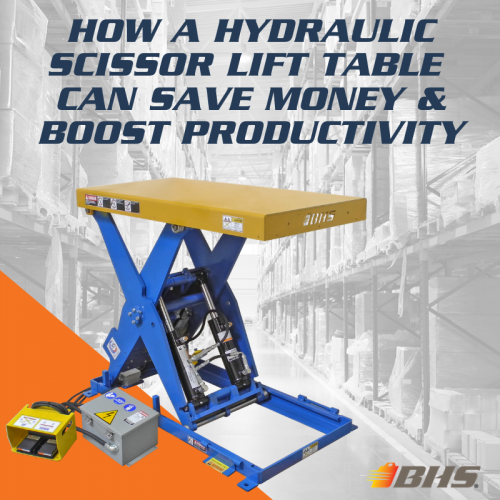We use cookies to make your experience better. To comply with the new e-Privacy directive, we need to ask for your consent to set the cookies. Learn more.
How a Hydraulic Scissor Lift Table Can Save Money and Boost Productivity

Of course, no investment in equipment is justified without proving a return. Scissor lift tables lower operational costs in three distinct ways:
- Hydraulic scissor lift tables reduce injury rates. At its core, any lift table is an ergonomic intervention. A 2016 report from the United States Bone and Joint Initiative found that one out of every two American adults are living with a musculoskeletal disorder. The astounding prevalence of these injuries leads to an estimated cost of $213 billion in health care and lost wages.Muskuloskeletal disorders can be caused by awkward, extreme, or repetitive motions in the workplace, including frequent bending and reaching, the very risk factors lift tables are designed to control.
- Work positioning can improve productivity. Comfortable workers get more done. The correlation between ergonomic improvements and better productivity has been supported by many studies over the years.Research from 2003 found that a circuit manufacturer saved nearly $575,000 per year after implementing an ergonomics program. A 2013 paper found that reducing ergonomic risk factors by 22.7 percent led to a productivity increase of 16 percent.
- Custom table tops integrate into existing facility infrastructure. Roller-conveyers simplify machine feeding. Ball transfer tops keep orders moving down the line. Turntables can move products without employees taking a step.
Hydraulic scissor lift tables are available with custom alterations to fit into any existing material flow. -
The primary ergonomic strength of a hydraulic scissor lift table is its ability to optimize work positioning. Keeping work close to the body, without arms lifted or extended, reduces tension and the attendant risk of injury. Lift tables allow any worker to position work where it’s comfortable for them, regardless of the setting used for the previous shift.
But lift tables do much more than position work comfortably. They raise, lower, and convey heavy loads in harsh industrial environments. Mobile Lift Tables can move loads across the facility, lowering for safe loading and unloading, while an ergonomic push bar makes transit easy.
In 2012, pain in the back and/or neck led to 290.8 million lost work days. The average annual cost to treat a single patient with a musculoskeletal disorder is close to $8,000. Preventing as many of these injuries as possible is a clear path to financial savings as well as improved public health. That’s why a hydraulic scissor lift table is nearly always a sound investment.
References:
American Academy of Orthopaedic Surgeons. "One in two Americans have a musculoskeletal condition: New report outlines the prevalence, scope, cost and projected growth of musculoskeletal disorders in the U.S." ScienceDaily. ScienceDaily, 1 March 2016. Web. 5 Dec. 2019.
Battevi, N. and N. Vitelli. “Ergonomics and productivity: an example applied to a manufacturing industry.” NLM. PubMed, May 2013. Web. 5 Dec. 2019.
Yeow, Paul and Rabindra Nath Sen. “Quality, productivity, occupational health and safety and cost effectiveness of ergonomic improvements in the test workstations of an electronic factory.” ScienceDirect. Elsevier Science B.V., Sept. 2003. Web. 5 Dec. 2019.
